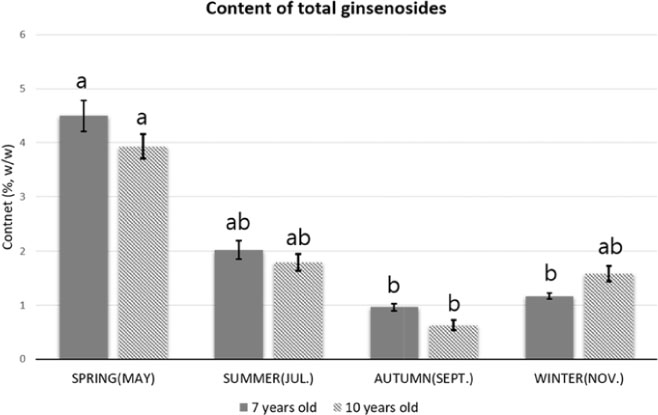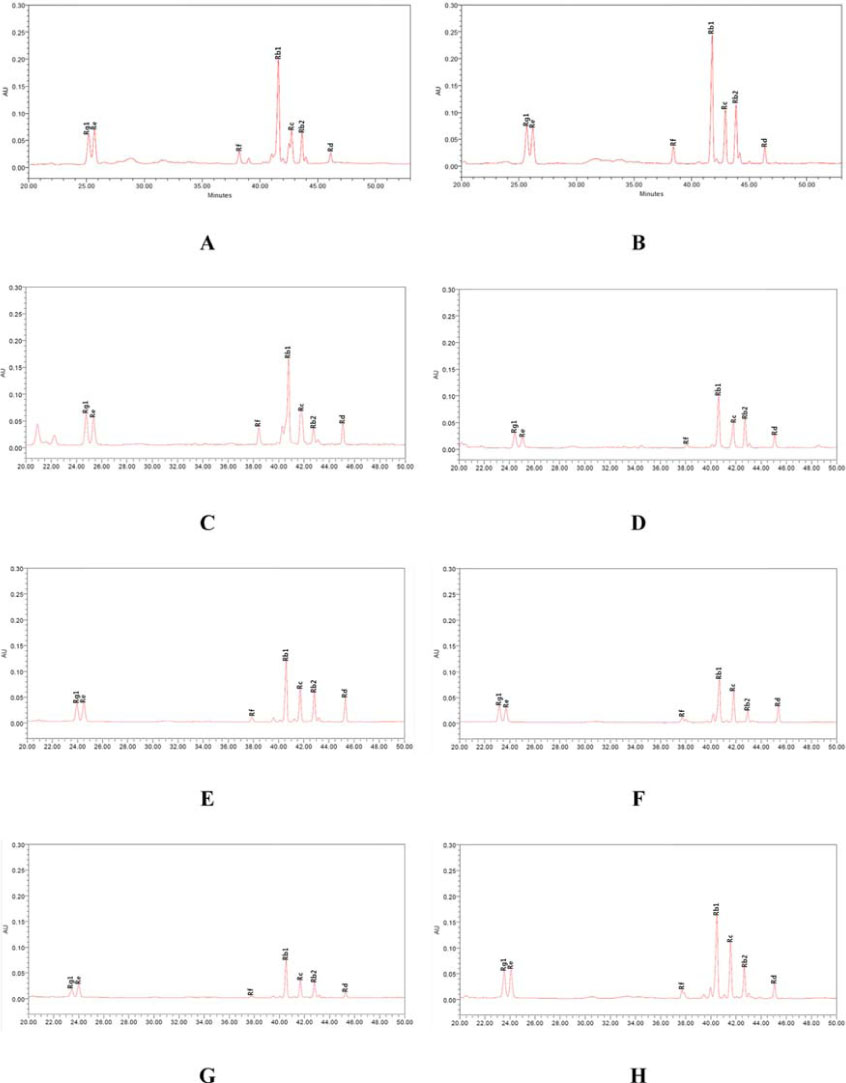Nat Prod Sci.
2019 Mar;25(1):1-10. 10.20307/nps.2019.25.1.1.
The Comparison of Seasonal Ginsenoside Composition Contents in Korean Wild Simulated Ginseng (Panax ginseng) which were Cultivated in Different Areas and Various Ages
- Affiliations
-
- 1Leaders in INdustry-university Cooperation+ (LINC+), Semyung University, Jecheon 27136, Korea.
- 2The Department of Oriental Medical Food & Nutrition, Semyung University, Jecheon 27136, Korea. skko@semyung.ac.kr
- 3Korea Forestry Promotion Institute, Seoul 07570, Korea.
- 4College of Pharmacy, Kangwon National University, Chunchon 24341, Korea. kimhc@kangwon.ac.kr
- KMID: 2443096
- DOI: http://doi.org/10.20307/nps.2019.25.1.1
Abstract
- The ginsenoside content was compared with wild simulated ginseng (Panax ginseng) collected every season at 11 wild simulated ginseng plantations in Korea. As a result, the total saponin of 7 years old wild simulated ginseng showed the highest content of 4.5% in spring sampling wild simulated ginseng, 2.0% in summer sampling wild simulated ginseng, 1.2% in winter sampling wild simulated ginseng and 1.0% in autumn sampling wild simulated ginseng. And also, the total saponin of 10 years old wild simulated ginseng showed the highest content of 3.9% in spring sampling wild simulated ginseng, summer sampling wild simulated ginseng (1.8%), winter sampling wild simulated ginseng (1.6%) and autumn sampling wild simulated ginseng (0.6%). Therefore, the total saponin of spring sampling wild simulated ginseng was about 4.5 - 6.5 times higher than that of autumn sampling wild simulated ginseng regardless of cultivation period.
Keyword
Figure
Reference
-
1. Ko SK, Leem KH. Korean J Herbol. 2009; 24:169–172.2. Ko SK, Im BO. Korean ginseng science. Seoul: Yakupsinmusa;2009. p. 33.3. Namba T. The Encyclopedia of Wakan-Yaku with Color Pictures (I). Osaka: Hoikusha;1980. p. 1.4. Park JD. Korean J Ginseng Sci. 1996; 20:389–415.5. Sanada S, Kondo N, Shoji J, Tanaka O, Shibata S. Chem Pharm Bull. 1974; 22:421–428.6. Kitagawa I, Taniyama T, Shibuya H, Noda T, Yoshikawa M. Yakugaku Zasshi. 1987; 107:495–505.7. Shibata S, Tanaka O, Ando T, Sado M, Tsushima S, Ohasawa T. Chem Pharm Bull (Tokyo). 1966; 14:595–600.8. Tanaka O, Nagai M, Shibata S. Chem Pharm Bull (Tokyo). 1966; 14:1150–1156.9. Lim W, Mudge KW, Weston LA. Planta Med. 2007; 73:71–76.10. Lui JHC, Staba EJ. J Nat Prod. 1980; 43:340–346.11. Lim W, Mudge KW, Vermeylen F. J Agric Food Chem. 2005; 53:8498–8505.12. Kim SJ, Shin SS, Seo BI, Jee SY. Korean J Herbol. 2004; 19:41–50.13. Hong MH, Lim HK, Park J, Jun NJ, Lee YJ, Cho M, Cho SK. J Appl Biol Chem. 2008; 51:102–107.14. Kim JH, Kim JK. J Korean Soc Food Sci Nutr. 2006; 35:1315–1321.15. Kwon KR, Cho AL, Lee SG. J Korean Pharmacopuncture Inst. 2003; 6:7–27.16. Yun SN, Moon SJ, Ko SK, Im BO, Chung SH. Arch Pharm Res. 2004; 27:790–796.17. Lee CR, Whang WK, Shin CG, Lee HS, Han ST, Im BO, Ko SK. Korean J Food Sci Technol. 2004; 36:847–850.18. Jang JG, Lee KS, Kwon DW, Nam KY, Choi JH. Korean J Food Nutr. 1983; 12:37–40.19. Han ST, Shin CG, Yang BW, Hahm YT, Sohn UD, Im BO, Cho SH, Lee BY, Ko SK. Food Sci Biotechnol. 2007; 16:281–284.20. Lee JB, Kim MU, Cho SH, Ko SK. Korean J Pharmacogn. 2017; 48:255–259.21. Lee JB, Yang BW, Park JD, Ko SK. Yakhak Hoeji. 2017; 61:274–280.
Article22. Ko SK, Lee KH, Hong JK, Kang SA, Sohn UD, Im BO, Han ST, Yang BW, Chung SH, Lee BY. Food Sci Biotechnol. 2005; 14:509–513.23. Kim SK, Sakamoto I, Morimoto K, Sakata M, Yamasaki KK, Tanaka O. Planta Med. 1981; 42:181–186.
- Full Text Links
- Actions
-
Cited
- CITED
-
- Close
- Share
- Similar articles
-
- Brief Introduction of Panax ginseng C.A. Meyer
- Quantitative Analysis of Dammarane-type Ginsenosides in Different Ginseng Products
- Production of Ginsenoside-Rg3 from Lipomyces starkeyi Grown on Ginseng-Steaming Effluent
- Diversity of Endophytic Fungi Isolated from Korean Ginseng Leaves
- The Change of Ginsenoside Composition in the Ginseng (Panax ginseng) Flower Buds by the Ultrasonication and Vinegar Process




